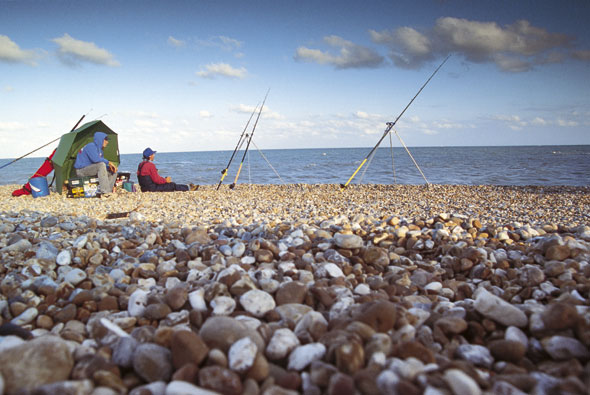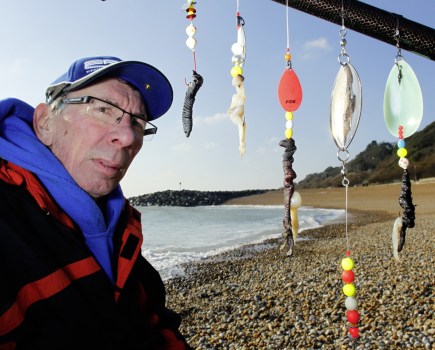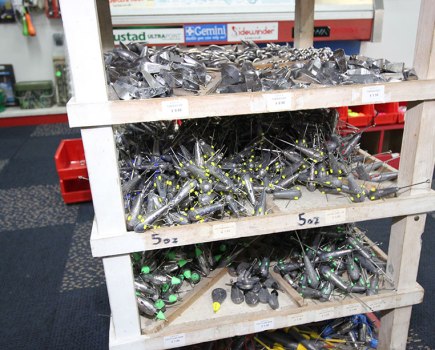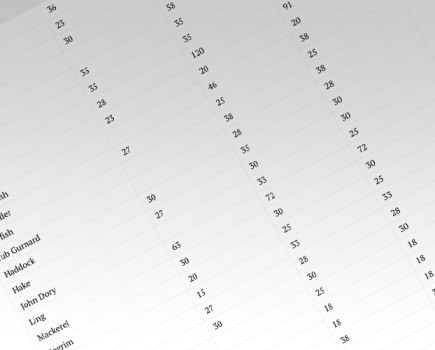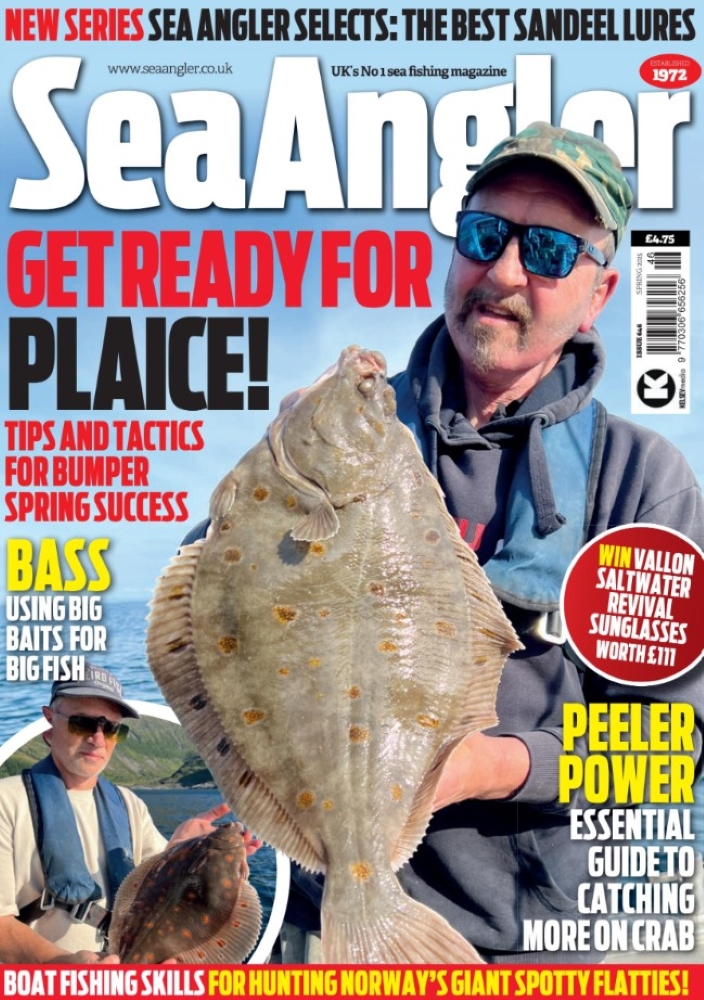Effective fishing is all about knowing what you are doing. Here our beach coach John Holden pulls 21 great fishing tips out of the bag that could make you a happier and more efficient beach fisherman…
Where to set up
On an average beach, set up camp above the high water line so that you do not need to move again throughout the tide cycle. Surf beaches and other flat marks must be fished by staying on the move, so keep your gear as light and compact as possible.
Casting from a clean, flat spot near the water’s edge obviously makes the best use of your casting range. The mistake is to insist on being down by the water when casting is easier if you stand further away – often the best bet on a steep shingle bank.
Anchoring tackle
The power of tidal currents usually comes as a nasty surprise when you first start beach fishing. It is essential to learn how to anchor the baited rig. Your neighbours on the beach won’t take kindly to tackle sweeping through their patch every cast.
 Fixed or swivelling wires?
Fixed or swivelling wires?
Fixed wire sinkers provide excellent anchorage with the advantage of being able to dig in again should the tackle move by accident or because you decide to shift the rig a few yards. The disadvantage is that they make retrieving much more difficult.
Swivelling wires hold steady until you want to wind in, when a firm pull triggers the wires to rotate out of the way. Retrieving is then easy and there is less chance of snagging along the way.
Swivel-wired sinkers are the way to go. Keep the breakout pressure high until you get used to the system. If you cannot produce the necessary tension by adjusting the wires alone, wrap a rubber band around them.
Walk uptide
Casting straight out is wrong when the tide is running hard because the wires never have a chance to grip the sea bed. The secret of success is to walk uptide before casting. Under normal circumstances, 25 yards is plenty.
Vicious spring tide currents need double that, and even then it pays to slant the cast yet further uptide.
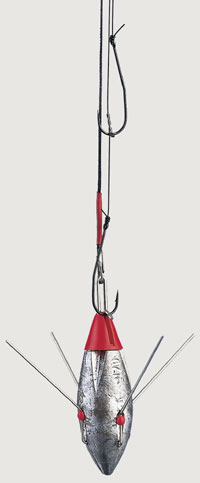 Aerodynamics
Aerodynamics
Clipping down the baited hook before letting fly makes sense even with simple rigs. Casting is easier, baits arrive on the sea bed in a much better condition and there is a distance bonus.
The best place for a clippeddown single bait is close behind the sinker. Nothing beats Breakaway’s Impact Shield system, which not only holds and protects, but also releases the bait at the end of the cast.
Choose the freestanding Impact Shield or the similar device built into the tail of a Breakaway lead. Excellent bait protection, easy to use and reliable.
Let out extra line
Slack line allows the grip leads to sink and the wires breathing space to dig themselves securely into the sea bed. Leave the reel out of gear while you walk back to your rod rest.
There is little risk of releasing too much extra line – 25 yards might not be enough on big tides.
Slack line bites
With this set-up, a rod usually flips upwards and the line falls slack when a biting fish grabs the bait and rips the anchor wires out of the sea bed.
Wind in quickly with the rod tip low until you feel resistance. Then lift the tip high and continue to wind.
The golden rule is never allow the line to fall slack again.
You might not know what’s on the end until the rig emerges from the sea – big cod and puny flatties often give the same dramatic bite. As do weeds and plastic bags.
Choosing rigs
Keep is simple – one hook, the best quality components all tied together with safe knots. Learn your craft on a basic fixed-link trace and then graduate to the more advanced tackle. I think that complex rigs catch more anglers than fish, but that is another story.
Tighten down
Rest the rod, then flip the reel into gear. The line tightens across the tide, with the baits anchored straight out or a little uptide. Fast currents create enough pressure to bend the rod tip right over.
On a more gentle tide, wind down until the rod flexes at the tip. This keeps the line under control and enhances a rod’s response to bites. At the other extreme, if the tackle fails to anchor firmly, wind in and try again before the bait drifts too far downtide. Changing to a heavier sinker might help.
Practising with rigs and grips
Round off a practice session by casting a wired sinker and baited rig. If the tide is running, practise the anchoring technique as well.
Adding a rig changes the feel of a cast. A baited tackle’s flight is slow and clumsy compared to a plain sinker alone. In the case of a multiplier reel, it might be necessary to alter the tuning slightly to compensate.
Regardless of reel, it is well worth getting used to all this before you go fishing. A pike angler’s polyball or a worm-like strip of plastic foam makes excellent bait substitutes for practice sessions. Include an Impact Shield or similar clipdown in your set-up so that you become familiar with the system.
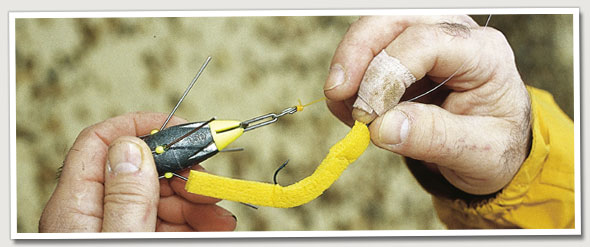
Off the ground with grip wires
You might think that launching a wired sinker from the ground would lead to all sorts of problems. Dirty beaches and exaggerated off-ground styles that drag the sinker can defeat clean lift-off, but the compact cast with an inside sinker lay-out is almost bulletproof. Other than not dumping the lead weight into a heap of weeds or among rocks, no special precautions are necessary.
Preserve your tackle
Dampness, salt and lack of airflow are a lethal cocktail that ruins tackle in a matter of hours. Much better to carry rods unwrapped and reels and other gear loose in your bait bucket. It also prevents messing up your tackle bags and boxes with sand and saltwater.
Getting unstuck
Snagged tackle is an occupational hazard. Wind down tight with the rod tip low, wrap the line around a piece of stick, then turn your back and walk slowly away from the sea until the tackle tears free or the line breaks.
On rare occasions, the sinker flies from the sea like a stone from a catapult, hence the wisdom of not facing the water as you pull.
It is worth modifying the technique on muddy ground. Wind down, then lift the rod tip and hold maximum safe tension long enough for the sinker wires or hooks to cut their way out of the mud in cheese-wire fashion. If the tackle does pop free, wind in at top speed so that you don’t get stuck again.
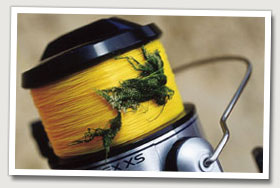
Weed on the line
Muck on the line destroys good casting. Every scrap must be removed each time you wind in. The worst culprit is the brown grass-like weed that infests the shoreline in autumn and winter. The quick cure for a mass of weed on the leader knot is to cut it off and re-tie.
Rod care
Wash off the salt and grit. Leave the rod to dry, then check it over. Most at risk are the tip ring and the joint. Tip rings are vulnerable to wear and accidentally damage. A light tap on the shingle can be enough to crack ring inserts or pop them out of the frame.
The tip rings of most of my rods have been changed to all-metal Diamite patterns. Spare tip rings and hot melt glue are always in my tackle box.
Sticky or binding joints are a nuisance, but the danger is that sand and grit will literally grind away the mating surfaces. Whether spigot, push-in or push-over, the joints must be clean and lightly waxed.
Repairs and spares
Experience will show you what spare parts, if any, are worth carrying. Modern tackle is generally reliable, so little should be necessary apart from the obvious items such as extra brake blocks. Insulating tape, pliers and a screwdriver are indispensable.
Where to fish
Although this series focuses on the mechanics of fishing, it is worth mentioning a few reasons why beginners fail to catch fish, although they have mastered the basic techniques.
The common mistake is fishing where there are no fish and the reason is that newcomers often prefer to keep to the sidelines. Fish the popular beaches, not the deserted spots. Provided that he is not a pest who cannot control his tackle or pushes into a space that has been left clear for good reason, beach fishing is a game where everyone is welcome.
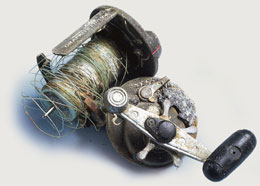
Reel care
Fixed-spools need a wash and dry followed by an inspection of bale arm, drag screw and the space behind the spool which often sucks in muck. Routinely, that is enough to keep good reels running.
Stripping down and re-lubrication should not be needed more than once a year. Cheap reels rot whatever you do. Treat them as disposable, for that is what they are.
Rinse multipliers under the tap and wipe them dry before taking out the spool and checking the innards. Re-oil lightly. Check the brake blocks. Back off the drag to prevent the washers and pads from binding.
When to fish
Fish arrive in the surf when they want to, not at an angler’s convenience. Seasons, weather and tides must all be taken into account. Find out the best times – and be there even if it means a midnight drive followed by a wet, icy session.
Join a club
Going it alone is a struggle, though for many anglers it is a challenge they enjoy. Even so, the shortcut to better sport is to fish with and learn from other anglers. Team up with people who really know what they are doing. The better the anglers you go with, the quicker you will become an expert.
Bait
Bait must be fresh, appropriate and generous. Few anglers are in a position to collect their own and the only worthwhile alternative is to find a top quality supplier, pay the price and stick with him. Good bait might seem expensive – actually, it is expensive – but it is still cheap compared to tackle, travelling, time and effort.
